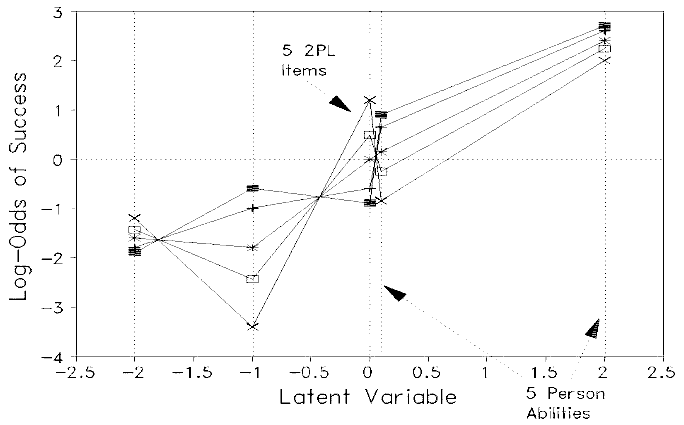
Plot: Local item difficulty of 5 2-PL items for 5 abilities
Many researchers who are attempting to measure latent constructs appreciate the special properties of the Rasch model and view it as an ideal model, but, at the same time, they tend to complain about the "inflexibility" of the model when it comes to "explaining" data. The two-parameter logistic model is then seen as a possible resort. However, with discrimination varying from item to item, the very meaning of the construct changes from point to point on the dimension. In other words, measurement in its true sense has not been achieved.
In the dichotomous Rasch model, for each item response only two parameters are relevant, the item location parameter δ and the person location parameter ξ (using Rasch's multiplicative notation). The probability of a correct response then is ξ / ( ξ + δ ) (Rasch 1960/1980, p.107). As Georg Rasch points out, if we knew the exact item parameter and the probability of a correct response, the person location could be computed directly. Vice versa, if we knew the person parameter and the probability, we could compute the item location. Under the two-parameter logistic (2-PL) model, this is not possible without further information because there are infinitely many combination of item difficulty and discrimination which yield the same probability for a given person location.
The plot shows the adjusted log-odds of success on five 2-PL items for persons at five ability levels. The five ability levels are -2, -1, 0, 0.1, and 2 logits. The items have difficulty and (discrimination) of -2 (0.8), -1.0 (1.8), 0.0 (0.4), 0.1 (1.5), and 2 (1.2). For each person-item encounter, the 2-PL probability of success is computed. This is converted into log-odds and adjusted for person ability. The plot thus shows the local Rasch difficulty of each item for each person. If the items were in accord with the Rasch model, this plot would collapse to an identity line. Since the 2-PL item characteristic curves intersect, there is a different "Rasch item difficulty" for each item for each level of person ability. In other words, the meaning of the construct defined by the item difficulty differs for each person location. Thus the apparent advantage of better describing the data set when using the 2-PL, rather than a Rasch model, comes at the expense of a highly fuzzy definition of the latent continuum . "Measurement" becomes an illusion, because there is no precise definition of what is being measured.
Thomas Salzberger
Vienna University of Economics and Business Administration
Austria
Rasch, Georg (1960/1980). Probabilistic Models for Some Intelligence and Attainment Tests. Danish Institute for Educational Research & https://www.rasch.org/books.htm

Plot: Local item difficulty of 5 2-PL items for 5 abilities
The illusion of measurement: Rasch versus 2-PL. Salzberger, T. … 16:2 p.882
The illusion of measurement: Rasch versus 2-PL. Salzberger, T. … Rasch Measurement Transactions, 2002, 16:2 p.882
| Forum | Rasch Measurement Forum to discuss any Rasch-related topic |
Go to Top of Page
Go to index of all Rasch Measurement Transactions
AERA members: Join the Rasch Measurement SIG and receive the printed version of RMT
Some back issues of RMT are available as bound volumes
Subscribe to Journal of Applied Measurement
Go to Institute for Objective Measurement Home Page. The Rasch Measurement SIG (AERA) thanks the Institute for Objective Measurement for inviting the publication of Rasch Measurement Transactions on the Institute's website, www.rasch.org.
| Coming Rasch-related Events | |
|---|---|
| Jan. 16 - Feb. 13, 2025, Fri.-Fri. | On-line workshop: Rasch Measurement - Core Topics (E. Smith, Winsteps), www.statistics.com |
| Apr. 8 - Apr. 11, 2026, Wed.-Sat. | National Council for Measurement in Education - Los Angeles, CA, ncme.org/events/2026-annual-meeting |
| Apr. 8 - Apr. 12, 2026, Wed.-Sun. | American Educational Research Association - Los Angeles, CA, www.aera.net/AERA2026 |
| May. 15 - June 12, 2026, Fri.-Fri. | On-line workshop: Rasch Measurement - Core Topics (E. Smith, Winsteps), www.statistics.com |
| June 19 - July 25, 2026, Fri.-Sat. | On-line workshop: Rasch Measurement - Further Topics (E. Smith, Winsteps), www.statistics.com |
The URL of this page is www.rasch.org/rmt/rmt162j.htm
Website: www.rasch.org/rmt/contents.htm